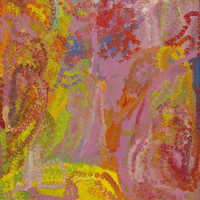54. EMILY KAME KNGWARREYE

Following her 1992 Australian Artists Creative Fellowship win the first for an Indigenous artist Emily Kame Kngwarreyes painting was filled anew with exploration, vigour and depth.
1993 is generally regarded as Kngwarreyes greatest colourist phase, the period in which her work became more uninhibited and her palette encompassed colours across the spectrum1. This vision and practice culminated in the Alhalkere Suite, a major work comprising twenty-two panels, which was first exhibited in the inaugural invitational Joan and Peter Clemenger Contemporary Art Award at the National Gallery of Victoria (1993), and later acquired by the National Gallery of Australia.
Since then, Kngwarreyes talent and significance has been rightly acknowledged and celebrated with numerous acquisitions, exhibitions and publications, including several international exhibitions of Australian art, and two solo retrospective exhibitions, most recently Utopia: The Genius of Emily Kame Kngwarreye, which toured Japan in 2008.
Author and art academic Terry Smith pinpoints Kngwarreyes use of colour in the period 199093 as key to her artistic motivation and innovation2. Within this painterly paradigm, Kngwarreyes seemingly tireless explorations of the possibilities of colour to enunciate personal narratives is astounding, both in terms of her vision and artistic virtuosity. This high colourist period produced a body of marvellous works exhibiting powerful synergies of energy and colour, such as Merne Alhalkere, 1993, the painting offered here.
Metaphorical language employed by critics talking about this period demonstrates the emotive power with which these paintings radiate. Margot Neale refers to the Alhalkere Suite as the crescendo in Kngwarreyes Colourism phase, revealing the full symphonic range of natures palette the way Emily may have experienced Alhalkere over a lifetime3. Elsewhere, Neale makes the connection between Kngwarreyes lifetime of ceremonial dancing, singing and mark-making and the rhythm of her paintings, which often exhibit a circularity in their composition, akin to the way womens body marking is performed from breast to breast, arm to arm4.
Kngwarreyes oeuvre focuses on the interconnectedness of her physical self and Country her home Alalgura (Alhalkere), situated near Soakage Bore, Utopia, north east of Alice Springs as well as the metaphysical associations of awelye (womens law ceremonies in the Anmatyerre language) and attendant custodial responsibilities for nurturing the land and its bounty.
Merne in Anmatyerre refers to various edible vegetation, such as fruits, tubers and leaves. The luscious work being offered here, Merne Alhalkere, 1993, utilises colours inspired by the flowers and fruits of Kngwarreyes country, including the bush plum alkwa and bush tomato akatjera.
In Delmore Gallerys descriptions of Kngwarreyes painterly lexicon, blue has been linked to water that feeds the Alhalkere soakage and surrounds, while trailings of different coloured dot work may indicate seasonal rains, as well as various levels of plant maturity. The flush of new growth that appears across Country after rain Kngwarreye joyfully referred to as green time. Kngwarreyes paintings of Country in this season are some of her most dramatic: her mark making reflecting the transformational power of rain in the desert. The plum does not fruit annually for example; it generates in response to rain, and when the plum is blue/purple, it is ripe and ready to eat.
Merne Alhalkere 1993 is thus both celebratory and reverential: on one level the painting is a joyous expression of the seasonal maturation of the bounty within Kngwarreyes Country, Alhalkere, and on another it speaks, or more appropriately, sings, about Kngwarreyes physical embodiment in the realm of awelye.
1. Ryan, J., In the Beginning is My End: The Singular Art of Emily Kame Kngwarreye, Emily Kngwarreye: Alhalkere Paintings from Utopia, Queensland Art Gallery, Brisbane, 1998, p.43
2. Smith, T., Kngwarreye Woman Abstract Painter, in Isaacs, J., Smith, T., and Ryan, J., et al, Emily Kngwarreye Paintings, Craftsman House, Sydney, 1998, pp.2442
3. Neale, M., Colourism, Utopia: The Genius of Emily Kame Kngwarreye, National Museum of Australia, Canberra, 2008, p.232
4. The Body in Two worlds: One Vision, ibid., p.27
Jane Raffan
BA Hons. (Fine Arts); Grad.Dip. Environmental Law (Ethical Dealing Art & Cultural Heritage)